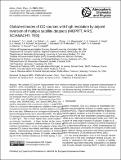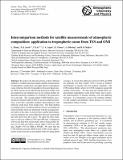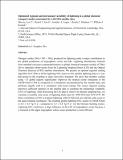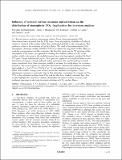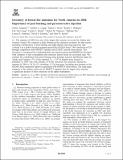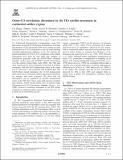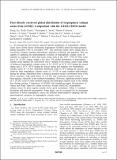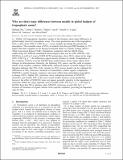Search
Now showing items 1-10 of 41
Global Estimates of CO Sources with High Resolution by Adjoint Inversion of Multiple Satellite Datasets (MOPITT, AIRS, SCIAMACHY, TES)
(European Geosciences Union, 2010)
We combine CO column measurements from the MOPITT, AIRS, SCIAMACHY, and TES satellite instruments in a full-year (May 2004–April 2005) global inversion of CO sources at 4°×5° spatial resolution and monthly temporal resolution. ...
Intercomparison Methods for Satellite Measurements of Atmospheric Composition: Application to Tropospheric Ozone from TES and OMI
(European Geosciences Union, 2010)
We analyze the theoretical basis of three different methods to validate and intercompare satellite measurements of atmospheric composition, and apply them to tropospheric ozone retrievals from the Tropospheric Emission ...
Optimized regional and interannual variability of lightning in a global chemical transport model constrained by LIS/OTD satellite data
(Wiley-Blackwell, 2012)
Nitrogen oxides (NOx≡ NO + NO2) produced by lightning make a major contribution to the global production of tropospheric ozone and OH. Lightning distributions inferred from standard convective parameterizations in global ...
Influence of Reduced Carbon Emissions and Oxidation on the Distribution of Atmospheric CO2: Implications for Inversion Analyses
(American Geophysical Union, 2005)
Recent inverse analyses constraining carbon fluxes using atmospheric CO2 observations have assumed that the CO2 source from atmospheric oxidation of reduced carbon is released at the surface rather than distributed globally ...
Global Budget of Ethane and Regional Constraints on U.S. Sources
(American Geophysical Union, 2008)
We use a 3-D chemical transport model (the GEOS-Chem CTM) to evaluate a global emission inventory for ethane (C2H6), with a best estimate for the global source of 13 Tg yr−1, 8.0 Tg yr−1 from fossil fuel production, 2.6 ...
Inventory of Boreal Fire Emissions for North America in 2004: The Importance of Peat Burning and Pyro-Convective Injection
(American Geophysical Union, 2007)
The summer of 2004 was one of the largest fire seasons on record for Alaska and western Canada. We construct a daily bottom-up fire emission inventory for that season, including consideration of peat burning and high-altitude ...
Ozone-CO Correlations Determined by the TES Satellite Instrument in Continental Outflow Regions
(American Geophysical Union, 2006)
Collocated measurements of tropospheric ozone (O3) and carbon monoxide (CO) from the Tropospheric Emission Spectrometer (TES) aboard the EOS Aura satellite provide information on O3-CO correlations to test our understanding ...
First Directly Retrieved Global Distribution of Tropospheric Column Ozone from GOME: Comparison with the GEOS-CHEM Model
(American Geophysical Union, 2006)
We present the first directly retrieved global distribution of tropospheric column ozone from Global Ozone Monitoring Experiment (GOME) ultraviolet measurements during December 1996 to November 1997. The retrievals clearly ...
Why Are There Large Differences Between Models in Global Budgets of Tropospheric Ozone?
(American Geophysical Union, 2007)
Global 3-D tropospheric chemistry models in the literature show large differences in global budget terms for tropospheric ozone. The ozone production rate in the troposphere, P(O x ), varies from 2300 to 5300 Tg yr−1 across ...
Fire and Biofuel Contributions to Annual Mean Aerosol Mass Concentrations in the United States
(Elsevier, 2007)
We estimate the contributions from biomass burning (summer wildfires, other fires, residential biofuel, and industrial biofuel) to seasonal and annual aerosol concentrations in the United States. Our approach is to use ...


